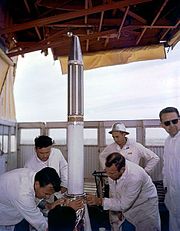Creation of NASA
TheNational Aeronautics and Space Administration(NASA) was created in 1958 from theNational Advisory Committee for Aeronautics(NACA), and other related organizations, as the result of theSpace Racebetween the United States and theSoviet Unionin the 1950s.
Background[edit]
From 1946, theNational Advisory Committee for Aeronautics(NACA) had been experimenting withrocket planes,such as the supersonicBell X-1.[1]In the early 1950s, there was a challenge to launch an artificial satellite for theInternational Geophysical Year(1957–58). An effort for this was the AmericanProject Vanguard.After theSoviet space programlaunched the world's first artificialsatellite(Sputnik 1) on October 4, 1957, the United States stepped up its own efforts. TheU.S. Congress,alarmed by the perceived threat to national security and technological leadership known as the "Sputnik crisis",urged immediate action, while PresidentEisenhowerand his advisers counseled more deliberate measures. This led to an agreement that a new federal agency based upon NACA was needed to conduct all non-military activity in space. TheAdvanced Research Projects Agencywas also created at this time to develop space technology for military application.[2]
Transition from NACA to NASA[edit]
From late 1957 to early 1958, the already existing National Advisory Committee for Aeronautics (NACA) began studying what a new non-military space agency would entail, as well as what its role might be, and assigned several committees to review the concept.[3]On January 12, 1958, NACA organized a "Special Committee on Space Technology", headed byGuyford Stever.[3]Stever's committee included consultation from theArmy Ballistic Missile Agency's large booster program, referred to as the Working Group on Vehicular Programs. This group was headed byWernher von Braun,[3]aGermanscientist who duringWorld War IIhad developed ballistic missiles such as theV-2 rocketforNazi Germanybefore being brought to the US inOperation Paperclip.

On January 14, 1958, NACA DirectorHugh Drydenpublished "A National Research Program for Space Technology" stating:[4]
It is of great urgency and importance to our country both from consideration of our prestige as a nation as well as military necessity that this challenge [Sputnik] be met by an energetic program of research and development for the conquest of space... It is accordingly proposed that the scientific research be the responsibility of a national civilian agency... NACA is capable, by rapid extension and expansion of its effort, of providing leadership inspace technology.[4]
Launched on January 31, 1958,Explorer 1,officially Satellite 1958 Alpha, became the U.S.'s first Earth satellite.[5]The Explorer 1 payload consisted of theIowa Cosmic Ray Instrumentwithout a tape data recorder which was not modified in time to make it onto the satellite.
On March 5,President's Science Advisory Committee(PSAC) ChairmanJames Killianwrote a memorandum to PresidentDwight D. Eisenhower,entitled "Organization for Civil Space Programs", encouraging the creation of a civil space program based upon a "strengthened and redesignated" NACA which could expand its research program "with a minimum of delay."[4]In late March, a NACA report entitled "Suggestions for a Space Program" included recommendations for subsequently developing a hydrogen fluorine fueledrocketof 4,450,000 newtons (1,000,000 lbf) thrust designed with second and third stages.[3]
In April 1958, Eisenhower delivered to the U.S. Congress an executive address favoring a national civilian space agency and submitted a bill to create a "National Aeronautical and Space Agency."[3]NACA's former role of research alone would change to include large-scale development, management, and operations.[3]The U.S. Congress passed the bill, somewhat reworded, as theNational Aeronautics and Space Actof 1958, on July 16.[3]Only two days later von Braun's Working Group submitted a preliminary report severely criticizing the duplication of efforts and lack of coordination among various organizations assigned to the United States' space programs.[3]Stever's Committee on Space Technology concurred with the criticisms of the von Braun Group (a final draft was published several months later, in October).[3]
On July 29, 1958, Eisenhower signed theNational Aeronautics and Space Act,establishing NASA. When it began operations on October 1, 1958, NASA absorbed the 46-year-old NACA intact; its 8,000 employees, an annual budget of US$100 million, three major research laboratories (Langley Aeronautical Laboratory,Ames Aeronautical Laboratory,andLewis Flight Propulsion Laboratory) and two small test facilities.[6]
Elements of theArmy Ballistic Missile Agency,of which von Braun's team was a part, and theNaval Research Laboratorywere incorporated into NASA. A significant contributor to NASA's entry into theSpace Racewith the Soviet Union was the technology from theGerman rocket program(led by von Braun) which in turn incorporated the technology ofRobert Goddard's earlier works.[7]Earlier research efforts within theU.S. Air Force[6]and many of ARPA's early space programs were also transferred to NASA.[8]In December 1958, NASA gained control of theJet Propulsion Laboratory,a contractor facility operated by theCalifornia Institute of Technology.[6]
References[edit]
- ^Uri, John (June 12, 2023)."95 years ago: First Human Rocket-Powered Aircraft Flight".NASA.Archivedfrom the original on November 13, 2023.RetrievedJune 21,2023.
- ^Tristan, David (July 29, 2022)."July 29, 1958: National Aeronautics and Space Administration is created".ABC27 WHTM.Archivedfrom the original on August 1, 2023.RetrievedDecember 30,2022.
- ^abcdefghiBilstein, Roger E. (1996). "From NACA to NASA". In Lucas, William R. (ed.).Stages to Saturn: A Technological History of the Apollo/Saturn Launch Vehicles.NASA.pp. 32–33.ISBN0-16-004259-3.SP-4206.Archivedfrom the original on 1 June 2023.RetrievedMay 27,2009.
- ^abcErickson, Mark (2005).Into the Unknown Together—The DOD, NASA, and Early Spaceflight(PDF).Air University Press.ISBN1-58566-140-6.Archived fromthe original(PDF)on September 20, 2009.
- ^Garber, Steve (October 10, 2007)."Explorer-I and Jupiter-C".NASA.Archivedfrom the original on 24 June 2023.RetrievedJuly 15,2009.
- ^abc"T. Keith Glennan".NASA.August 4, 2006. Archived fromthe originalon November 18, 2022.RetrievedJuly 15,2009.
- ^von Braun, Werner (1963)."Recollections of Childhood: Early Experiences in Rocketry as Told by Werner Von Braun 1963".MSFC History Office.NASA Marshall Space Flight Center. Archived fromthe originalon August 21, 2012.RetrievedJuly 15,2009.
- ^Van Atta, Richard (April 10, 2008)."50 years of Bridging the Gap"(PDF).Archived fromthe original(PDF)on February 24, 2009.RetrievedJuly 15,2009.
